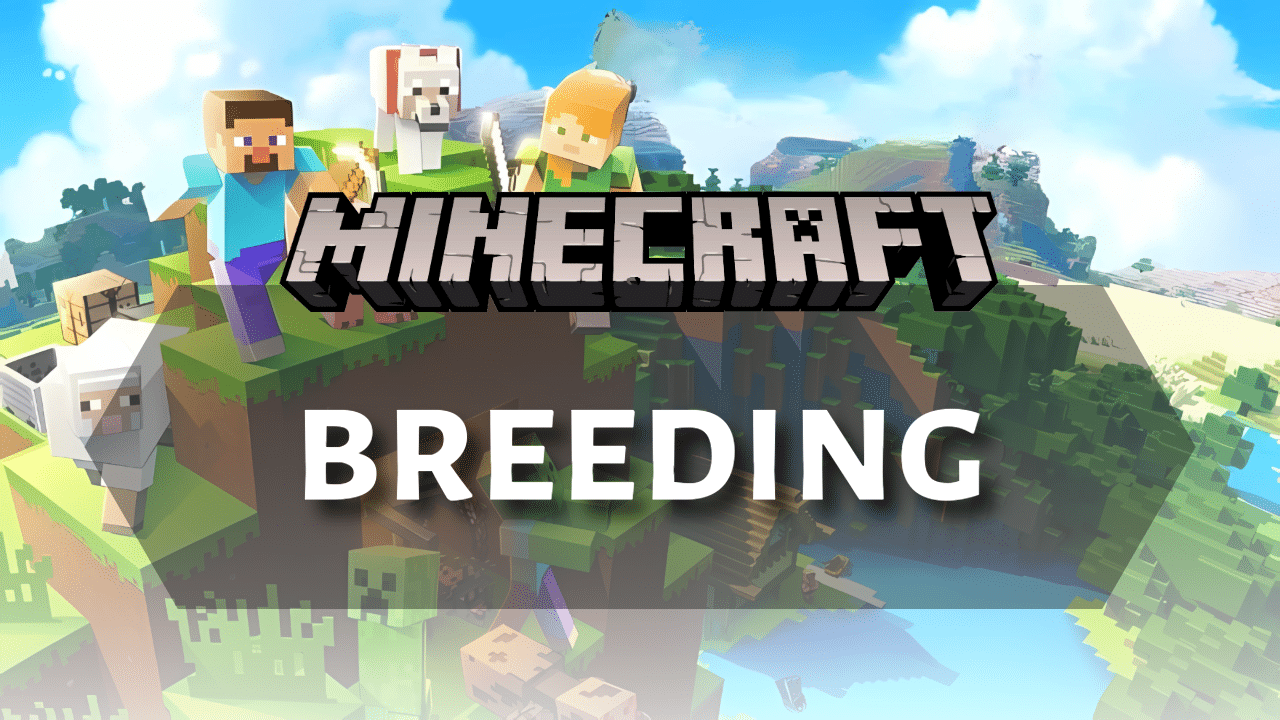
Introduction
Breeding animals in Minecraft Bedrock Edition is a fundamental aspect of gameplay, allowing you to establish sustainable resources like food and wool, expand your animal populations, and even obtain useful transportation and companionship. This Minecraft Bedrock Breeding Guide focuses specifically on breeding animals in Minecraft Bedrock Edition, outlining the necessary steps and preferred foods for each breedable mob. By understanding the mechanics of breeding, you can efficiently manage your virtual ecosystem and ensure a steady supply of valuable items.
How to Breed Animals
Generally, breeding animals in Minecraft Bedrock involves feeding two animals of the same type their specific preferred food. Once fed, they will enter “love mode,” indicated by the appearance of flying hearts. If two animals in love mode are within eight blocks of each other, they will mate and produce a baby. After breeding, there is a cooldown period of approximately five minutes before the same animals can breed again. It is advisable to keep breeding animals in a secure, enclosed area to prevent them from escaping.
Breedable Mobs
Axolotl
Axolotls in Minecraft are amphibious mobs that can be bred by feeding two adults a bucket of tropical fish, producing a baby axolotl. These creatures are valuable allies in underwater combat, as they attack hostile aquatic mobs like drowned and guardians, making ocean exploration safer. When injured, axolotls can play dead, regenerating health while distracting enemies, which enhances their survival in battles. Additionally, players who assist axolotls in combat receive temporary regeneration and have mining fatigue removed, making them strategically useful in underwater structures like ocean monuments.
Bee
Bees in Minecraft are neutral mobs that can be bred by feeding them any type of flower, including Flowering Azalea, Cherry Leaves, and Spore Blossom. Once two bees are fed, they enter “love mode” and produce a baby bee, expanding the colony for increased honey production. Bees are essential for honey farming, as they collect nectar and return to their hives to produce honey, which can be harvested and crafted into useful items like sugar and honey blocks. Additionally, their natural pollination behavior speeds up crop growth, making them a valuable asset for efficient farming and resource gathering.
Camel
Camels in Minecraft are passive mobs that can be bred by feeding them cacti, producing a baby camel to expand their population. Unlike most rideable mobs, camels can carry two players at once, making them ideal for cooperative travel across deserts and open landscapes. Their tall stature provides an advantage by keeping riders above the reach of certain hostile mobs, offering additional safety during nighttime exploration. Camels also feature a unique dash ability, allowing them to quickly traverse obstacles like ravines and rivers, making them a versatile and strategic choice for long-distance travel.
Cat
Cats in Minecraft are passive mobs that can be tamed using raw cod or raw salmon. Once tamed, feeding them the same raw fish will induce “love mode,” allowing them to breed and produce kittens. Tamed cats must be at full health to breed, ensuring successful reproduction. Beyond companionship, cats offer practical benefits, such as deterring creepers and phantoms, providing players with added security during exploration and base defense. Cats also exhibit unique behaviors, including the tendency to sit on chests, beds, and active furnaces, which can be both endearing and strategically useful by preventing access to these items. Additionally, when a player sleeps, a tamed cat may gift them with various items upon waking, such as string or phantom membranes, adding a layer of utility to their presence.
Chicken
Chickens are passive mobs that can be bred by feeding them various seeds, including wheat, pumpkin, melon, beetroot, torchflower seeds, or pitcher pods. Once bred, they produce a chick immediately and continue to lay eggs autonomously without additional feeding. These eggs can be collected and thrown, offering a one-in-eight chance to spawn a new chick, facilitating easy expansion of your poultry farm. Managing a flock of chickens provides a steady supply of eggs, which are essential ingredients in crafting recipes for pumpkin pie and cake, enhancing your food resources. Beyond egg production, chickens are valuable sources of raw chicken and feathers upon death. Cooking raw chicken yields cooked chicken, a nutritious food item that restores a significant amount of hunger points, making it a reliable sustenance option during adventures. Feathers obtained from chickens are crucial for crafting arrows, enabling ranged combat capabilities
Cow
Cows in Minecraft are passive mobs that can be bred by feeding them wheat, producing a calf that grows into an adult over time. They serve as a crucial source of raw beef and leather, essential for crafting books, armor, and food. When killed, cows drop leather and raw beef, but if they die while on fire, they provide cooked steak instead, making them a reliable food source. Additionally, milking a cow with a bucket yields milk, which can be used in recipes like cake and removes negative status effects, making cows valuable for both survival and farming.
Donkey
Donkeys in Minecraft are passive mobs that can be tamed by repeatedly riding them until they accept the player, indicated by heart particles. Once tamed, they can be bred with golden apples or golden carrots, producing a foal, though breeding them with horses results in mules that cannot reproduce. Their most valuable feature is their ability to carry chests, providing portable storage for long journeys and making resource gathering more efficient. While slower than horses, donkeys’ ability to transport goods makes them indispensable for exploration and large-scale building projects.
Fox
Foxes in Minecraft are nocturnal, passive mobs that can be bred by feeding them sweet berries or glow berries. Baby foxes born through breeding will trust the player who bred them, making them easier to tame and manage. They have the unique ability to pick up and hold items in their mouths, which can enhance their attacks if they acquire enchanted weapons. Additionally, foxes are skilled hunters, naturally preying on chickens, rabbits, and fish, making them useful for players who want an automatic source of these resources.
Frog
Frogs in Minecraft are passive mobs that can be bred by feeding two adult frogs slimeballs, causing one to become pregnant and subsequently lay frogspawn in a nearby water source. After approximately ten minutes, the frogspawn hatches into tadpoles, which mature into adult frogs over time. The biome in which the tadpoles grow determines the frog’s variant: temperate (orange), warm (white), or cold (green). Beyond their breeding mechanics, frogs are particularly useful for producing froglight blocks; when a frog consumes a small magma cube, it drops a froglight corresponding to its color variant, serving as a decorative and luminous building material.
Goat
Goats in Minecraft are neutral mobs found in mountainous regions and can be bred by feeding them wheat. They are known for their ramming ability, which can knock back players and mobs, making them both unpredictable and useful. When a goat rams into a solid block, it has a chance to drop a goat horn, which produces unique sounds when played. Additionally, goats can be milked with a bucket, providing a renewable source of milk to remove status effects or use in crafting recipes.
Hoglin
Hoglins in Minecraft are hostile mobs found in the Nether’s Crimson Forest and Bastion Remnants and can be bred by feeding them crimson fungus. Despite being breedable, they remain aggressive toward players, making hoglin farming a challenge without proper precautions. Unlike most mobs, they cannot be bred while fleeing from warped fungi, Nether portals, or respawn anchors, which naturally repel them. While hoglins drop raw porkchops and leather when killed, they cannot survive in the Overworld, as they transform into zombified hoglins (zoglins) shortly after leaving the Nether.
Horse
Horses in Minecraft Bedrock are passive mobs that must be tamed by repeatedly riding them until they accept the player, signified by heart particles. Once tamed, they can be bred using a golden apple, enchanted golden apple, or golden carrot, which also accelerates the taming process. Horses are among the fastest land-based mounts, making them ideal for efficient travel across vast biomes, especially in multiplayer gameplay. Additionally, breeding a horse with a donkey produces a mule, which inherits the carrying capacity of a donkey but, unlike its parents, cannot breed.
Llama
Llamas in Minecraft are passive mobs that must be tamed by repeatedly riding them until they stop bucking the player off. Once tamed, they can be bred by feeding them hay bales, which also accelerates the taming process. Unlike horses, llamas cannot be ridden directly with a saddle, but they can be equipped with carpets for decoration and used as pack animals. Their ability to form caravans and carry storage chests makes them highly useful for transporting large quantities of items across long distances.
Mooshroom
Mooshrooms in Minecraft are rare cow variants found exclusively in mushroom biomes and can be bred by feeding them wheat. They provide all the benefits of regular cows but also produce mushroom stew when milked with a bowl, making them a renewable food source. Additionally, using shears on a mooshroom transforms it into a regular cow and drops several mushrooms of its respective color. Mooshrooms can also be struck by lightning, causing them to change between red and brown variants, each offering different types of stew when fed certain flowers.
Ocelot
Ocelots in Minecraft are elusive jungle-dwelling mobs that can be bred by feeding them raw cod or raw salmon. While they do not require taming before breeding, feeding them repeatedly will make them trust the player, preventing them from running away. Unlike cats, ocelots cannot be kept as pets, but their presence can help deter creepers, making them useful for base defense. Establishing an ocelot population in jungle biomes adds to the game’s immersive wildlife while providing strategic advantages against hostile mobs.
Panda
Pandas in Minecraft are neutral mobs that can be bred by feeding them bamboo, but they require at least eight bamboo plants within a five-block radius to enter love mode. Their unique personality traits, such as playful, lazy, or aggressive behaviors, make them one of the most diverse mobs in the game. Unlike most animals, pandas can sneeze, sometimes dropping slimeballs, and baby pandas have a chance to perform adorable rolls. Establishing a panda habitat not only enhances the aesthetic of jungle biomes but also provides an engaging and dynamic wildlife experience.
Pig
Pigs in Minecraft are passive mobs that can be bred by feeding them carrots, potatoes, or beetroots, making them a reliable source of porkchops for food. When killed, they drop raw porkchops, which can be cooked to restore more hunger, making them an essential part of any sustainable farm. Additionally, pigs can be ridden using a saddle and controlled with a carrot on a stick, offering a fun but slower alternative to horses for transportation. Establishing a pig farm ensures a steady supply of food while also providing an entertaining way to explore the world.
Rabbit
Rabbits in Minecraft are small, skittish mobs that can be bred by feeding them dandelions, carrots, or golden carrots. Due to their tendency to flee from players, holding a breeding item is essential for keeping them nearby. When killed, rabbits drop rabbit hides, raw rabbit, and occasionally rabbit’s foot, which is used to craft potions of leaping. Establishing a rabbit farm provides valuable resources for crafting, brewing, and food while adding a lively touch to any environment.
Sheep
Sheep in Minecraft are passive mobs primarily valued for their wool and mutton, making them essential for both decorative and survival purposes. By breeding them with wheat, players can maintain a steady supply of wool, which is used for crafting beds, banners, and carpets. Their unique color inheritance system allows for the creation of different wool colors, providing customization options for builds. Establishing a sheep farm ensures a renewable source of wool and food, making them a valuable resource for both early and late-game progression.
Sniffer
Sniffers in Minecraft are ancient, passive mobs that can be bred by feeding them torchflower seeds. Once bred, they lay eggs that hatch into snifflets after twenty minutes, or in half the time if placed on a moss block. These creatures specialize in digging up ancient seeds from the ground, making them useful for discovering unique plant life. By breeding and raising sniffers, players can cultivate rare decorative plants, adding new biodiversity to their Minecraft worlds.
Strider
Striders in Minecraft are passive mobs that thrive in the Nether and can be bred by feeding them warped fungus. They are the only rideable mobs that can walk on lava, making them essential for safe Nether travel across vast lava lakes. When equipped with a saddle and controlled using a warped fungus on a stick, striders provide a reliable and efficient means of transportation in the otherwise hazardous terrain. Breeding and utilizing striders can significantly improve mobility in the Nether, reducing the risks associated with lava-filled environments.
Turtle
Turtles are bred by feeding them seagrass, which can be found on the ocean floor. After breeding, turtles will return to their home beach to lay eggs on sand. These eggs take a long time to hatch (around 4-5 in-game days or about 2.5 hours in real time) and are fragile, susceptible to being trampled by zombies or other entities. Turtle eggs can only be obtained with Silk Touch.
Wolf
Wolves must first be tamed with bones before they can be bred by feeding them any kind of meat (raw beef, raw chicken, raw porkchop, raw mutton, raw rabbit, rotten flesh), cooked meat (steak, cooked chicken, cooked porkchop, cooked rabbit, cooked mutton). Tamed wolves must be at full health to breed and must not be sitting. You can use dye to change the color of a tamed wolf’s collar.
Villager
It is important to note that villager breeding is different from animal breeding. Villagers breed passively based on the number of available beds and the amount of food they have. To encourage villager breeding, ensure there are enough beds for the existing villagers plus at least one extra, and provide them with food such as bread, carrots, or potatoes. Trading with villagers can also increase their willingness to breed.
Conclusion
In conclusion, animal breeding in Minecraft Bedrock Edition is a crucial mechanic that supports survival, resource management, and exploration. By understanding each mob’s breeding requirements and conditions, players can efficiently grow their farms, gather essential materials, and enhance their overall gameplay. Some animals require taming, while others have specific environmental needs, making breeding both a strategic and rewarding process. Mastering these mechanics ensures a sustainable world, providing food, materials, and companions for any adventure.
If you’re looking for more guides, be sure to explore the website for more tips and tricks. Enjoy your adventure, and happy mining!
Frequently Asked Questions(FAQs)
🍄What’s the cooldown for breeding again?
5 minutes for adults; babies take 20 minutes to grow up (can be sped up with food).
🍄Can mobs breed on their own?
No, you must feed them manually.
🍄Can I breed different types of animals?
No, only the same species can breed.













